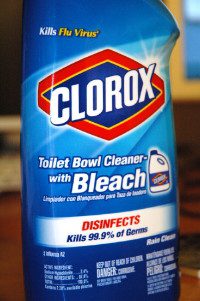

Influenza is an infection of the respiratory tract. The virus enters the tract in aerosols or by contact with saliva or other respiratory secretions from an infected individual. Common toilet use is not a risk factor for transmission of influenza, because there is no evidence that the virus replicates in the human intestine. Some avian H5N1 subtypes appear to be able to multiply outside the respiratory tract in humans, but such infections are rare.
It’s more likely that the ‘Kills Flu Virus’ label is a marketing ploy to sell more toilet cleaner. People are in general afraid of influenza, and may be reassured by the idea of eliminating the virus from all areas of their home. The product website indicates that the toilet bowl cleaner ‘kills’ common cold rhinoviruses. Considering that rhinoviruses do not replicate in the alimentary tract, this activity also appears to be superfluous.
If you look closely at the lower left hand part of the bottle, just above the ingredient list (click image for a larger view) you will see the words “Influenza A2”. This is not correct influenza virus nomenclature so I don’t know exactly what Clorox has in mind. However, I would not be surprised if this were replaced with ‘swine flu’ in the near future.
I have no doubt that Clorox Toilet Bowl Cleaner will inactivate influenza virus (viruses cannot be killed, as they are not living). The active ingredient is sodium hypochlorite, commonly known as bleach, a widely used disinfectant. In my laboratory, we keep beakers of 5% sodium hypochlorite in our cell culture hoods for inactivating viruses.
There are certainly other microbes that should be removed from our toilets. Examination of the back of the bottle indicates that the product will inactivate rotavirus, a major cause of gastroenteritis. This makes perfect sense, as rotavirus is present in feces. It is well known that toilet flushing produces aerosols that can spread infectious diseases. In the paper cited below, the authors deliberately contaminated a toilet with enteric bacteria (Serratia marcescens) and a virus (bacteriophage MS2). Serratia and MS2 were detected in the air after the first flush. Subsequent flushing also released microorganisms into the air, although the numbers declined after each flush. The authors conclude:
Many individuals may be unaware of the risk of air-borne dissemination of microbes when flushing the toilet and the consequent surface contamination that may spread infection within the household, via direct surface-to-hand-to mouth contact. Some enteric viruses could persist in the air after toilet flushing and infection may be acquired after inhalation and swallowing.
There is evidence that plumbing was responsible for spread of SARS coronavirus during the 2003 epidemic. In contrast to influenza virus, it is clear that the SARS coronavirus can replicate in the human gastrointestinal tract, and that fecal shedding is a significant mechanism of transmission.
It’s good practice to use bleach-containing cleansers to sanitize toilets, but it is not likely to have an impact on transmission of influenza. Unless you routinely sneeze into the toilet.
Barker, J., & Jones, M. (2005). The potential spread of infection caused by aerosol contamination of surfaces after flushing a domestic toilet Journal of Applied Microbiology, 99 (2), 339-347 DOI: 10.1111/j.1365-2672.2005.02610.x

Good point. I am also sick of all this marketing strategies trying to sell more of their products (in general, not only bleach) by taking advantage of the fear and ignorance (lack of knowledge) of the consumers.
this is not only for toilets but also for surfaces, water, dishwater,laundry,…
WHO has warned that Mexflu could be in bowels since GI-symptoms
are common (other than with normal flu)
I know one way respiratory secretions could get in the toilet, just ask any hungover college student.
Having GI symptoms does not mean the virus is in the GI tract – there
are other ways for viruses to cause such symptoms without replicating
there. The incidence of GI symptoms with 2009 H1N1 virus infections
needs to be examined by looking for virus in feces.
On Wed, Jun 10, 2009 at 2:05 AM,
Toilet seats are much cleaner than faucets, soap dispenser and countertop in a public restroom.
Public phones are much worse. Computer keyboards harbor a lot of germs too.
The good news is that unlike hepatitis viruses that can survive outside of the body for days and even months (Hepatitis A), flu virus is much more fragile.
It can live for 24-48 hours on hard surfaces, 8-12 hrs on soft surfaces. It remains infectious for only 2 to 8 hrs after its life on a hard surface and only up to a few minutes after being deposited on a soft surface outside of the body: http://www.phac-aspc.gc.ca/alert-alerte/swine-p…
Somebody for sure is going to drink this to prevent the flu. Poor Clorox will need a new warning label. Thanks for explaining the medical nomenclature in a way that a non virologist can understand. This student of life likes your site – Regards
I learned this in undergrad microbio. This is why you should close your toilet lid when you flush (and not keep your toothbrush near your toilet).
Then again our crazy scottish professor also claimed aluminium foil was superior to soft absorbent toilet paper…
The powerful clinging action removes stains while deodorizing with a fresh, clean scent.
The Pureflush germ filtering toilet seat is a patented technology that filters and destroys bacteria and viruses at the source…the Toilet Bowl.
I agree with you. Influenza virus is very dangerous, keep your bathroom always clean.
I agree with you. Influenza virus is very dangerous, keep your bathroom always clean.
For me. bathroom is the most dirtiest part of the house. Keeping it clean is a one way to keep your self healthy.
Good day!
This is a great article.
Toilet cleaner is use to maintain a clean and odorless washroom.
Thank you!
Looks like you’ve done your research very well.
Pingback: BrillseatThe Best Sanitary Toilet Covers can Save a Life